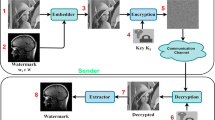Abstract
This paper presents some novel watermarking approaches that are based on vector quantization and provide ownership protection in gray-level images. Nowadays, information sharing in P2P architecture is immensely involved with knowledge-learning on the Internet. Copyright protection is therefore considered in the studies of P2P systems. The proposed approaches combine images, watermarks, and codebooks together by generating key streams to claim ownership and guarantee the integrity of images. Non-embedded approaches that generate claimed key streams have the benefit of maintaining the authorized image in its original state without any modifications. Compared to Lin et al.’s method, our approaches save both running time and space for storage. Moreover, in order to provide broader applications of image protection, robust watermark and fragile watermark strategies are proposed. The experimental results show that these strategies are effective.










Similar content being viewed by others
Notes
In Lin et al.’s paper, the equation is defined as Secret = Index mod \( \left[ {\sum\limits_{i=0}^{t-1 } {{2^i}} } \right] \). However, this is an error. For example, when t is 2, the possible secrets are 0, 1, and 2. Thus, watermark bits (11)2 will never be correlated to any block.
References
Run RS, Horng SJ, Lai JL, Kao TW, Chen RJ (2012) An improved SVD-based watermarking technique for copyright protection. Expert Syst Appl 39(1):673–689
Rawat S, Raman B (2012) Best tree wavelet packet transform based copyright protection scheme for digital images. Opt Commun 285(10–11):2563–2574
Chen WM, Lai CJ, Wang HC, Chao HC, Lo CH (2011) H.264 video watermarking with secret image sharing. IET Image Process 5(4):349–354
Guerrini F, Okuda M, Adami N, Leonardi R (2011) High dynamic range image watermarking robust against tone-mapping operators. IEEE Trans Inf Forensics Secur 6(2):283–295
Liu F, Wu CK (2011) Robust visual cryptography-based watermarking scheme for multiple cover images and multiple owners. IET Inf Secur 5(2):121–128
Aslantas V, Ozer S, Ozturk S (2009) Improving the performance of DCT-based fragile watermarking using intelligent optimization algorithms. Opt Commun 282(14):2806–2817
Alattar AM (2004) Reversible watermark using the difference expansion of a generalized integer transform. IEEE Trans Image Process 13(8):1147–1156
Sachnev V, Kim HJ, Nam J, Suresh S, Shi YQ (2009) Reversible watermarking algorithm using sorting and prediction. IEEE Trans Circ Syst Video Technol 19(7):989–999
Zhang W, Shih FY (2011) Semi-fragile spatial watermarking based on local binary pattern operators. Opt Commun 284(16–17):3904–3912
Li HF, Chang N, Chen XM (2010) A study on image digital watermarking based on wavelet transform. J China Univ Posts Telecommun 17(1):122–126
Phadikar A, Maity SP, Verma B (2011) Region based QIM digital watermarking scheme for image database in DCT domain. Comput Electr Eng 37(3):339–355
Patra JC, Phua JE, Bornand C (2010) A novel DCT domain CRT-based watermarking scheme for image authentication surviving JPEG compression. Digit Signal Process 20(6):1597–1611
Keyvanpour MR, Merrikh-Bayat F (2011) Robust dynamic block-based image watermarking in DWT domain. Procedia Comput Sci 3(1):238–242
Lu W, Sun W, Lu H (2009) Robust watermarking based on DWT and nonnegative matrix factorization. Comput Electr Eng 35(1):183–188
Lin CC, Hu YC, Chang CC (2006) A novel image ownership protection scheme based on rehashing concept and vector quantization. Fundam Inform 71(4):443–451
Wang FH, Jain LC, Pan JS (2007) VQ-based watermarking scheme with genetic codebook partition. J Netw Comput Appl 30(1):4–23
Shen JJ, Ren JM (2010) A robust associative watermarking technique based on vector quantization. Digit Signal Process 20(5):1408–1423
Pan JS, Huang HC, Wang FH (2002) A VQ-based robust multi-watermarking algorithm. In: 2002 IEEE Region 10 Technical Conference on Computers, Communications, Control and Power Engineering (TENCON’02), vol. 1. pp. 117–120
Lu ZM, Xu DG, Sun SH (2005) Multipurpose image watermarking algorithm based on multistage vector quantization. IEEE Trans Image Process 14(6):822–831
Linde Y, Buzo A, Gray R (1980) An algorithm for vector quantizer design. IEEE Trans Commun 28(1):84–95
Acknowledgments
This research was partially supported by the National Science Council of the Republic of China under the Grants NSC 101-2218-E-008-003-, NSC 101-2221-E-153-002-MY2, and NSC 100-2221-E-015-001-MY2.
Author information
Authors and Affiliations
Corresponding author
Rights and permissions
About this article
Cite this article
Wang, WJ., Huang, CT., Yang, CH. et al. VQ-based algorithms extended to non-embedded watermarking for multimedia ownership prevention systems. Peer-to-Peer Netw. Appl. 7, 676–686 (2014). https://doi.org/10.1007/s12083-012-0191-1
Received:
Accepted:
Published:
Issue Date:
DOI: https://doi.org/10.1007/s12083-012-0191-1




